 After all these commentaries, we move to the smattering of programs found on DVD Two. There we find one long-form documentary. Entitled Journey to the Screen: the Making of Pearl Harbor, the first lasts for 47 minutes and 25 second as it covers the creation of the film itself. The program combines the standard array of movie clips, shots from the set, and interview snippets. In regard to the latter, we hear from a long list of folks. In addition to film participants such as director Michael Bay, producer Jerry Bruckheimer, actors Ben Affleck, Cuba Gooding, Kate Beckinsale, Jon Voight, Alec Baldwin, and Josh Hartnett, Department of Defense Project Officer Lt. Melissa Shuermann, DOD Public Affairs Phil Strub, writer Randall Wallace, costume designer Michael Kaplan, special effects coordinator John Frazier, stunt coordinator Kenny Bates, aerial coordinator Alan Purwin, chief pilot Steve Hinton, property master Charles Stewart, director of photography John Schwartzman, first assistant director K.C. Hodenfield, second unit director/visual effects supervisor Eric Brevig, co-visual effects supervisor Ed Hirsh, and associate visual effects supervisor Ben Snow, we also get comments from veterans Don Jones, James Bunting, Robert Vilcone, Gene Byers, John Russak, Peter Janovich, Charles Tompkins, Archie Boek, Loyd Scott, Van Harrison, Edmond Chappell, William Davis, Richard Duran, Richard Fiske, Karl Johnson, Rik Richards, Hank Potter, Dick Cole, and Robert Kronberg. Wow - that’s a lot of folks to pack into a 47-minute show!
After all these commentaries, we move to the smattering of programs found on DVD Two. There we find one long-form documentary. Entitled Journey to the Screen: the Making of Pearl Harbor, the first lasts for 47 minutes and 25 second as it covers the creation of the film itself. The program combines the standard array of movie clips, shots from the set, and interview snippets. In regard to the latter, we hear from a long list of folks. In addition to film participants such as director Michael Bay, producer Jerry Bruckheimer, actors Ben Affleck, Cuba Gooding, Kate Beckinsale, Jon Voight, Alec Baldwin, and Josh Hartnett, Department of Defense Project Officer Lt. Melissa Shuermann, DOD Public Affairs Phil Strub, writer Randall Wallace, costume designer Michael Kaplan, special effects coordinator John Frazier, stunt coordinator Kenny Bates, aerial coordinator Alan Purwin, chief pilot Steve Hinton, property master Charles Stewart, director of photography John Schwartzman, first assistant director K.C. Hodenfield, second unit director/visual effects supervisor Eric Brevig, co-visual effects supervisor Ed Hirsh, and associate visual effects supervisor Ben Snow, we also get comments from veterans Don Jones, James Bunting, Robert Vilcone, Gene Byers, John Russak, Peter Janovich, Charles Tompkins, Archie Boek, Loyd Scott, Van Harrison, Edmond Chappell, William Davis, Richard Duran, Richard Fiske, Karl Johnson, Rik Richards, Hank Potter, Dick Cole, and Robert Kronberg. Wow - that’s a lot of folks to pack into a 47-minute show!
For the most part, “Journey” integrates the speakers reasonably well, though don’t expect to hear much from most of them. Bay dominates the piece, but even he only adds a little to the table. Still, the large variety of voices helps bring some decent facts to bear. Though a promotional show at heart, “Journey” happily keeps the film clips to a minimum; they don’t fill too much of the program. Where the show shines relates to the “behind the scenes” snippets. These provide some nice looks at the creation of the movie and they flesh out the piece. Overall, “Journey” is a bit too fluffy and light to be much above average, but it still offers a fairly interesting look at many aspects of the production.
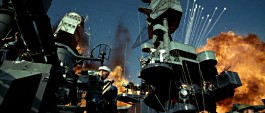 A few minor extras round out the DVD. In addition to a preview for National Geographic Beyond the Movie: Pearl Harbor, we find a music video for Faith Hill’s “There You’ll Be”. This clip appears in a 2.35:1 ratio and features Dolby Digital 5.1 sound. The song itself is yet another crappy Diane Warren ballad, and the video resembles many other clips that promote tunes from movies; it uses liberal film snippets and simply shows Hill as she wanders around and lip-synchs the rest of the time. Hill looks pretty good in the video, but it’s still a loser.
A few minor extras round out the DVD. In addition to a preview for National Geographic Beyond the Movie: Pearl Harbor, we find a music video for Faith Hill’s “There You’ll Be”. This clip appears in a 2.35:1 ratio and features Dolby Digital 5.1 sound. The song itself is yet another crappy Diane Warren ballad, and the video resembles many other clips that promote tunes from movies; it uses liberal film snippets and simply shows Hill as she wanders around and lip-synchs the rest of the time. Hill looks pretty good in the video, but it’s still a loser.
DVD Two concludes with an Easter egg. Highlight the apparently empty space next to the spot for the music video. This brings up a red star; click “enter” and you’ll get to see a 10-minute “gag reel” completed for the movie’s wrap party. The last 170 seconds of this just shows a montage of film clips, but the first seven minutes, 10 seconds provide a variety of goofy bits. Most of it seems a bit ordinary, but some funny moments appear. It merits a look if just to see Affleck and Hartnett spoof an infamous moment from Armageddon.
With that, we move to DVD Three, where we really start to dig in to the extras. The disc splits into two areas: “The Film” and “The History”. Within “The Film”, we begin with the Production Diary, which consists of 10 vignettes. Each of those lasts between three minutes, 52 seconds and seven minutes, 52 seconds for a total of 62 minutes and 46 seconds of footage.
Not surprisingly, all of these vignettes deal with effects sequences. With the exception of “Doolittle Raid”, they all concern scenes that appear during the attack on Pearl Harbor. Mostly we see behind the scenes footage of the filmmakers at work. Of course, this focuses on Bay, but we see many other participants as well. Helpfully, the 1.78:1 material provides captions at the bottom of the screen. Those identify various members of the crew and also offer some various elements of the production. We also occasionally find video insets in the bottom left of the screen; those offer things like raw daily footage, for example. A few split-screens appear as well to show both sides of a scene. Most of the featurettes end with the appropriate footage from the finished film.
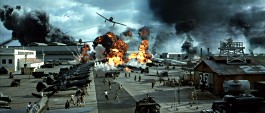 As far as the audio goes, we usually hear the raw production audio from the set. However, some interview segments appear on top of a few segments. “Nurse Strafing” provides remarks from actors Sara Rue, Catherine Kellner, Kate Beckinsale, and Jennifer Garner. “Arizona Dive” features director Bay, producer Jerry Bruckheimer, actor Ben Affleck and Department of Defense Project Officer Melissa Schuermann. “Doolittle Raid’ includes those same folks as well as actor Alec Baldwin, first assistant director K.C. Hodenfield, executive producer Barry Waldman, Department of Defense Liaison Officer Philip Strub, and writer Randall Wallace.
As far as the audio goes, we usually hear the raw production audio from the set. However, some interview segments appear on top of a few segments. “Nurse Strafing” provides remarks from actors Sara Rue, Catherine Kellner, Kate Beckinsale, and Jennifer Garner. “Arizona Dive” features director Bay, producer Jerry Bruckheimer, actor Ben Affleck and Department of Defense Project Officer Melissa Schuermann. “Doolittle Raid’ includes those same folks as well as actor Alec Baldwin, first assistant director K.C. Hodenfield, executive producer Barry Waldman, Department of Defense Liaison Officer Philip Strub, and writer Randall Wallace.
Though it’s not all gems, the “Production Diary” includes a lot of great material. It provides a fun look at the production process. I love to see raw footage from the set, as I think little else shows the way this works quite as well. Say what you want about Bay, but he doesn’t worry about how he looks or sounds in this kind of situation, so we see plenty of uncensored footage; he screams and spazzes his way through much of the production. (By the way, does Bay ever wear clothes that don’t tout one of his movies?)
Seven of the vignettes can be viewed with commentary from director Michael Bay. He doesn’t directly address the onscreen action, though. His remarks often connect to the material, such as when he discusses his experiences during “Dorrie Miller”. However, his statements mostly deal with general filmmaking issues, such as the pre-shoot blessing apparently mandated by Hawaiian law. (How is that possibly Constitutional?) I wish Bay spoke over more of the footage, but he provided some good information nonetheless.
Boot Camp provides two featurettes that examine the training given to the actors. “Soldiers’ Boot Camp” looks at the experiences of Josh Hartnett, Ben Affleck, and Ewan Bremner as well as some of the other actors. In this 15-minute and 53-second piece, we see raw footage of the camp as the drill sergeant bosses around the performers. Hartnett seems to handle things well, but Affleck usually looks pretty peeved, especially when the drill sergeant berates Bremner over his handling of a meal exchange. It’s a fun little program.
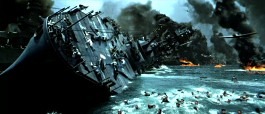 “Officers’ Boot Camp” focuses on Alec Baldwin and lasts six minutes, five seconds. Mostly this follows Baldwin as he goes through various wargame activities. It seems much less strenuous than the physical toil through which the others went. Actually, parts of it remind me of a paintball game, and we also see an interesting exercise in which soldiers create a human ladder. Still, it’s a good look into Baldwin’s experiences.
“Officers’ Boot Camp” focuses on Alec Baldwin and lasts six minutes, five seconds. Mostly this follows Baldwin as he goes through various wargame activities. It seems much less strenuous than the physical toil through which the others went. Actually, parts of it remind me of a paintball game, and we also see an interesting exercise in which soldiers create a human ladder. Still, it’s a good look into Baldwin’s experiences.
According to the DVD, creative advisor Mark Palansky shot the footage that would act as Navy newsreel material. In the Super 8 Montage, we see some of his outtakes that didn’t make the movie. This clip runs for four minutes, 35 seconds. The grainy black and white footage provides an interesting look at the material shot for the movie.
“The Film” concludes with a couple of ads. We see both the theatrical and teaser trailers for Pearl Harbor. Oddly, the teaser offers Dolby Digital 5.1 sound, whereas the standard trailer provides only Dolby Surround 2.0 audio.
When we go to “The History”, we discover two long programs and one short featurette. One Hour Over Tokyo looks at the Doolittle raid depicted in the film’s final act. Hosted by Roger Mudd and narrated by D. Paul Thomas, the show lasts 45 minutes and 57 seconds and it consists of historical footage and photos plus interviews with a mix of figures. We hear from raid flight personnel Richard Cole, Chase Nielsen, Horace Crouch, Jacob DeShazer, Thomas Griffin, J. Royden Stark, Robert Hite, Henry Potter, Robert Bourgeois, and Nolan Herndon plus Chinese college student (at the time) Tung-Sheng Liu and author Col. Carroll V. Glines (The Doolittle Raid). We also get a little archival audio of Doolittle himself.
“Tokyo” starts a little slowly as it covers the basics of the raid. Pearl Harbor actually did a pretty good job of relating that information, so I didn’t find a lot of new details in those parts of this documentary. However, the program becomes much more interesting once it addresses the aftermath of the raid. We learn a lot about the fates of the crews captured by the Japanese, especially since we hear from many of the former prisoners. Overall, “Tokyo” offers a fairly good look at its subject.
 Originally aired as a special on the History Channel, Unsung Heroes of Pearl Harbor gives us a second documentary. Narrated by Fritz Weaver, this 45-minute and 20-second program combines archival films and still photos with interviews. In the latter domain, we hear from USS Arizona Memorial historian Daniel Martinez, author Paul Stillwell (Air Raid: Pearl HarborRun Silent, Run Deep) and Colonel Joseph H. Alexander (A Fellowship of Valor), and veterans Roger Thomas, Stephen B. Young, and Anthony J. Dilorenzo.
Originally aired as a special on the History Channel, Unsung Heroes of Pearl Harbor gives us a second documentary. Narrated by Fritz Weaver, this 45-minute and 20-second program combines archival films and still photos with interviews. In the latter domain, we hear from USS Arizona Memorial historian Daniel Martinez, author Paul Stillwell (Air Raid: Pearl HarborRun Silent, Run Deep) and Colonel Joseph H. Alexander (A Fellowship of Valor), and veterans Roger Thomas, Stephen B. Young, and Anthony J. Dilorenzo.
Overall, the program tends toward the melodramatic at times, but it offers a pretty good recap of the events of December 7 1941. The show stays away from a broad historical or political focus and essentially concentrates on the attack itself. In that regard, it provides a fairly thorough look at the different elements, with a special emphasis on the various ships that took hits. I especially liked the comments from the veterans; in particular, Young - a survivor of the Arizona - added a strong perspective. Ultimately, “Unsung” wasn’t an exceptional documentary, but it gave us a reasonably compelling view of its subject.
For the final component of “The History”, we find Oral History: The Recollections of a Pearl Harbor Nurse. During this five-minute and 40-second piece, we hear the recreation of statements from Lt. Ruth Erickson. The audio remembrances appear over a mix of historical photos and film. It’s a short but interesting look at the nurses’ side of things on December 7, 1941.
Oddly, all the timings listed for the programs in “The History” are wrong. They miss their marks by a few minutes. With one exception on DVD Four, this problem doesn’t appear to affect the other discs, so it seems strange that it occurs here.
 Now we push on toward DVD Four, where we discover a slew of additional materials. The “Visual Effects” area offers the majority of the disc’s components in three sections. Called the Interactive Attack Sequence, the first will give your DVD player’s remote a serious workout as you learn more about the film’s depiction of the attack on Pearl Harbor. The area provides a myriad of visual and auditory options. In the former category, the domain includes four video choices. You can watch the final cut of the scene found in the finished movie as well as raw footage from the set and a combination of storyboards and animatics; the latter also shows a little bit of historical film footage. The fourth option lets you check out the other three all at once on one screen.
Now we push on toward DVD Four, where we discover a slew of additional materials. The “Visual Effects” area offers the majority of the disc’s components in three sections. Called the Interactive Attack Sequence, the first will give your DVD player’s remote a serious workout as you learn more about the film’s depiction of the attack on Pearl Harbor. The area provides a myriad of visual and auditory options. In the former category, the domain includes four video choices. You can watch the final cut of the scene found in the finished movie as well as raw footage from the set and a combination of storyboards and animatics; the latter also shows a little bit of historical film footage. The fourth option lets you check out the other three all at once on one screen.
As for the audio choices, we get an amazing seven selections. These include the final Dolby Digital 5.1 track along with another mix that isolates effects and a different one that spotlights music. You can also listen to the clips with production audio from the set. The other three choices provide various commentaries. One features visual effects supervisor/second unit director Eric Brevig, while another offers storyboard artist Robbie Consing. The final audio track gives us remarks from Pearl Harbor survivors.
In regard to the visual options, I didn’t have a lot of use for the final film image, but the other two seemed good. The shots from the set expanded on the material seen during the “Production Diary”. The area offered a lot of good shots of the basic footage. The storyboards and animatics area didn’t seem quite as interesting, but they helped let us see the manner in which the scenes were developed.
The various commentaries added some nice information. Brevig’s track revealed some good notes about the effects; I especially liked his discussion of Bay’s imperative to “add more war”. Consing provides nice remarks about his field. He covers the specifics of some of his work for Pearl and he also gives us a solid discussion of how he got into the field and recommendations for others who want to follow in his footsteps. Brevig’s track can be a little dry, but Consing’s seems lively and entertaining.
 As for the Pearl Harbor survivors, we hear from a wide variety of them. In a nice touch, we get some comments from Japanese pilots as well as US personnel. Not surprisingly, the American guys dominate, but I appreciate the modest attempt at balance. The various men offer a lot of interesting and useful remarks about the events and their own perspectives.
As for the Pearl Harbor survivors, we hear from a wide variety of them. In a nice touch, we get some comments from Japanese pilots as well as US personnel. Not surprisingly, the American guys dominate, but I appreciate the modest attempt at balance. The various men offer a lot of interesting and useful remarks about the events and their own perspectives.
I seriously doubt many people will want to check out every permutation of this section. The basic piece lasts 27 minutes and 38 seconds. With seven audio tracks and three visual options - not including the cumulative screen - it’d require almost 10 hours to go through all the variations! If you have the inclination then go for it, but to make the most of your time, I recommend these options:
Combine the Brevig commentary with the shots from the set;
Combine the Consing commentary with the storyboards/animatics angle;
Combine the Pearl Harbor survivors with the angle that shows all three images (it’s the only one that lists the names of the speakers);
Combine the production audio with the shots from the set;
Combine the music-only and effects-only tracks with the final film footage.
Even with these shortcuts, it’ll still take you almost three hours to work through the options, but that’s what it takes to get the most from this area.
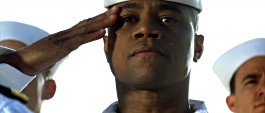 Next within the “Visual Effects” domain we move to Deconstructing Destruction. The main feature provides a chat with director Michael Bay and visual effects supervisor/second unit director Eric Brevig as they look at the creation of the movie’s main effects sequences. This segment lasts 21 minutes and 16 seconds.
Next within the “Visual Effects” domain we move to Deconstructing Destruction. The main feature provides a chat with director Michael Bay and visual effects supervisor/second unit director Eric Brevig as they look at the creation of the movie’s main effects sequences. This segment lasts 21 minutes and 16 seconds.
Within the main program, occasionally an icon appears in the lower right corner of the screen. Hit “enter” when this happens and you’ll see “branching” segments that add information about the various sequences. These include interviews with Brevig as well as visual effects associate supervisor Ben Snow and co-visual effects supervisor Ed Hirsh. The 10 clips run between 45 seconds and four minutes, 47 seconds for a total of 21 minutes, 46 seconds of footage. (The DVD incorrectly states that these pieces add up to 27 minutes, 46 seconds - maybe that was a typo.)
Within the Bay/Brevig parts, they sit next to each other and watch reels of effects demonstrations. They then comment on these to let us know the basics of how they were executed. They crack on each other a bit; actually, Bay does most of the joking, and he usually concentrates on the amount of money it all cost. The information appears in a loose but useful way that provides a nice layer of depth to the subject.
As for the “branching” bits, they cover the same material but do so with a little more detail. Brevig handles most of the 10 clips. All three men convey some good facts about the effects and I enjoyed the snippets. However, these may seem like overkill for some people, as they do simply expand upon the main clips. They’re valuable if you really want that closer look.
Very early in the preparation for Pearl Harbor, director Bay authorized the creation of the Animatic Attack sequence. The final component of the “Visual Effects” domain, this five-minute and 43-second clip shows a cheap CGI rendition of the bombing scene, the Battle of Britain and the Doolittle raid that they used to convince both the studio and the military that the project merited their attention. On top of the animatic we hear remarks from Bay, production designer Nigel Phelps, director of photography John Schwartzman, special effects supervisor John Frazier, aerial unit director David B. Nowell, chief pilot Steve Hinton, and producer Jerry Bruckheimer. Other parts of the animatics appear elsewhere on the DVD, but it’s good to see the whole thing, and the commentary adds solid information.
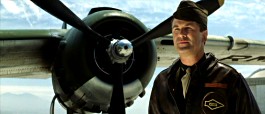 After this we jump to an Interactive Time Line, a deep look at the roots of the war between the US and Japan. Called “When Cultures Collide: From Perry to Pearl Harbor”, it starts in 1846 and continues until 1941. This area splits into 20 topic-specific segments, each of which runs between 116 seconds and five minutes, 38 seconds. Taken together, this adds up to a 68-minute and 42-second program. Happily, if you examine the “Timeline Index”, you’ll find a “Continuous Play” option, so you don’t need to examine each section on its own.
After this we jump to an Interactive Time Line, a deep look at the roots of the war between the US and Japan. Called “When Cultures Collide: From Perry to Pearl Harbor”, it starts in 1846 and continues until 1941. This area splits into 20 topic-specific segments, each of which runs between 116 seconds and five minutes, 38 seconds. Taken together, this adds up to a 68-minute and 42-second program. Happily, if you examine the “Timeline Index”, you’ll find a “Continuous Play” option, so you don’t need to examine each section on its own.
Narrated by David Ogden Stiers, the documentary shows a mix of archival materials beneath his lines. These components include photos, drawings, and film footage. Muted music runs throughout the show, and occasional effects appear as well, but Stiers’ speech remains the focal point of this chatty program. That tendency makes “Collide” a little dry at times, but it nicely sums up the road to war. It offers a reasonably engaging and concise history that lets viewers better understand why Pearl Harbor eventually occurred.
After this we get a collection of six Still Galleries. “Production Design” splits into seven subsections for a total of 47 images. “Publicity” divides into five smaller domains and gives us 50 shots in all. “Historical” provides 41 shots, while “Storyboards” includes a whopping 338 frames of material. Most of those screens show single drawings, but toward the end we see some full sheets of art. We also get to look at some excellent conceptual paintings near the conclusion of the collection. ”ILM” offers five unsurprisingly dull photos of their staff at work, while “Stan Winston Special Effects Makeup” offers 26 screens of their gruesome work.
Lastly, Disc Four of Pearl Harbor tosses in some DVD-ROM materials. The package claims that we’ll get the Definitive Bibliography, but what this means is that we find a bunch of links to external websites. There are 16 connections in all, which actually is a pretty good collection, I must admit. In addition, the DVD-ROM area includes a link to the movie’s official Website.
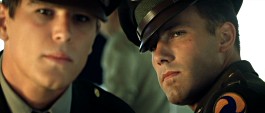 The “VISTA” release of Pearl Harbor provides unusual packaging that fans may or may not embrace. A paper slipcover embraces a paper case that resembles a soldier’s journal. When you open it, the far left flap reveals a “telegram” that presents President Roosevelt’s December 8, 1941 address to Congress.
The “VISTA” release of Pearl Harbor provides unusual packaging that fans may or may not embrace. A paper slipcover embraces a paper case that resembles a soldier’s journal. When you open it, the far left flap reveals a “telegram” that presents President Roosevelt’s December 8, 1941 address to Congress.
In the next space to the right, you’ll locate all four of the set’s DVDs. These appear in small paper sleeves that sit on top of each other; in other words, you need to flip past the first DVD to get to the second, then the third, etc.
Another flap shows up next, and when you open it, you’ll discover the package’s booklet. This 24-page piece includes a quick disc-specific summary of the set’s supplements, a note from Michael Bay, chapter listings, a short text about the history of the attack, and a long listing of the various programs. The piece also includes a nice selection of photos and artwork. The booklet includes some mistakes - it omits the names of some audio commentary participants, leaves off one of the “Interactive Attack Sequence” tracks, and mentions a non-existent program called “Journey to the Screen” - but it still gives us a solid little extra.
Continuing through the package, the next flap includes four postcards that replicate movie poster art. The remaining flaps show photos and art from the movie.
I admired the ambition of the packaging, and thought it seemed successful for the most part. Despite the complicated integration of the different components, it doesn’t take too much effort to get to the location with the DVDs themselves; it’d be much more annoying to have to open endless flaps to find them.
 However, I didn’t like the cardboard sleeves for the discs. They open outward, so it’s not too tough to get to discs three and four, but it can still become awkward, and the potential to scratch the DVDs seems higher than usual. I found it clumsy to manipulate the set and simply remove each disc. Still, while I didn’t think the package was a total success, I liked the fact that it tried to make the set something special.
However, I didn’t like the cardboard sleeves for the discs. They open outward, so it’s not too tough to get to discs three and four, but it can still become awkward, and the potential to scratch the DVDs seems higher than usual. I found it clumsy to manipulate the set and simply remove each disc. Still, while I didn’t think the package was a total success, I liked the fact that it tried to make the set something special.
This “VISTA” Series release of Pearl Harbor marks the film’s third incarnation on DVD. Two of them came out simultaneously in December 2001. These include the “60th Anniversary Commemorative Edition” detailed in the initial review linked at the start of this one as well as the “Gift Set”. The latter duplicates the “Commemorative Edition” and also includes the “definitive companion program, National Geographic Beyond the Movie: Pearl Harbor.”
In addition to that documentary, the “Gift Set” provides “three exclusive bonus programs: an actual Pearl Harbor newsreel and two historic archival films documenting some of the least known stories of the time - Japanese Relocation and The Army Nurse.” Finally, the “Gift Set” features National Geographic’s “60th Anniversary Pearl Harbor Commemorative Map”. All of this adds $20 to the list price of the basic release; the “Gift Set” retails for $49.99, as opposed to the $29.99 of the normal DVD.
For the record, the materials from the “Gift Set” can also be purchased separately, though it’ll cost you some extra bucks. Beyond the Movie lists for $29.99 on its own, while the map can be bought for $14.95. Since that comes to almost an extra $45, the $20 difference between the standard DVD and the “Gift Set” starts to look pretty good if the materials interest you.
However, if that package does appeal to you, you’ll probably want the “VISTA” set. Unfortunately, exhaustive as it seems, the “VISTA” DVD doesn’t include those pieces. Nonetheless, it appears to be the package of choice for most people. Had this set featured the bits from the “Gift Set”, it’d obviously be the only one anyone needs, but I’d still definitely recommend the “VISTA” release over all the others, at least for those who like supplements.
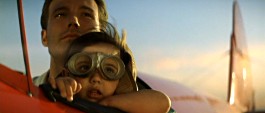 If you only care about the movie, then go with the original DVD. Of course, it tosses in a few extras as well, but it’s the cheapest package of the three, and it provides picture and sound quality that seem identical to what I witnessed in the “VISTA” set. At this point, I can’t recommend the “Gift Set” to anyone anymore. If they packaged the “VISTA” release with the “Gift Set”, then I might do so, but those who wants the latter’s video and map should buy them on their own so they can also get the “VISTA” version.
If you only care about the movie, then go with the original DVD. Of course, it tosses in a few extras as well, but it’s the cheapest package of the three, and it provides picture and sound quality that seem identical to what I witnessed in the “VISTA” set. At this point, I can’t recommend the “Gift Set” to anyone anymore. If they packaged the “VISTA” release with the “Gift Set”, then I might do so, but those who wants the latter’s video and map should buy them on their own so they can also get the “VISTA” version.
All these different packages confuse the issue somewhat, but here’s the bottom line: unless they truly dislike supplements, Pearl Harbor fans should get the “VISTA” release. Actually, this set is so terrific that I believe a lot of folks who didn’t like the movie will still want it. I’d definitely recommend it to Pearl Harbor buffs, even if they thought the film stunk; the package includes so much good historical material that it merits a purchase simply on that basis.
The “VISTA” release of Pearl Harbor appears to be the most exhaustive DVD package released to date. Amazingly, not only does it toss in scads of different materials, but also virtually all of them are good. Other DVDs shove in the filler but offer little of substance. That isn’t the case here. From the three audio commentaries to the historical documentaries to the hours and hours of footage about the making of the film, just about everything seems interesting and informative. I can’t call Pearl Harbor my favorite DVD simply because I’m not wild about the movie; I like it but don’t possess any strongly positive feelings toward it. However, the “VISTA” series release of Pearl Harbor redefines the concept of the “special edition” DVD; almost everything else will look skimpy compared to this monster.
Return to page 1

